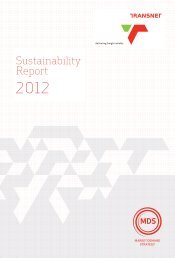Standard Operating Procedures for Container Terminals ... - Transnet
Standard Operating Procedures for Container Terminals ... - Transnet
Standard Operating Procedures for Container Terminals ... - Transnet
Create successful ePaper yourself
Turn your PDF publications into a flip-book with our unique Google optimized e-Paper software.
any other terminal within the Port, the container so landed or shipped will<br />
not be regarded as a transhipment container;<br />
1.1.13. “day” means any day of any month as designated on a calendar;<br />
1.1.14. “the Customer’s visitors” means the duly authorised servants, agents<br />
and independent contractors of the Customer, and as well as any<br />
persons whom the agent or contractor requests to be allowed or is<br />
granted access to the Customer’s vessels. The Customer must<br />
observe and procure that the Customer’s visitors observe the <strong>Standard</strong><br />
Terms and Conditions <strong>for</strong> visitors to the <strong>Terminals</strong> in COT Appendix “B”;<br />
1.1.15. “VAT” means Value Added Tax, which will be charged at the standard<br />
rate applicable at the time the service was rendered by the Terminal<br />
Operator;<br />
1.1.16. “co-loader” means the party(ies) who have been granted the right by the<br />
Customer to submit discharge or loading documentation without the prior<br />
consent of the Vessel Operator;<br />
1.1.17. “the agent” means the Customer’s local agent as notified to the Terminal<br />
Operator in terms of Clause 2.2.4.2 of these SOPCT;<br />
1.1.18. “direct re-stow” means the movement of a container by a container<br />
gantry crane from a position on a vessel to another position in the same<br />
bay on the same vessel without the container being temporarily placed<br />
on the quay or elsewhere on the vessel;<br />
1.1.19. “indirect re-stow” means the movement of a container from a position on<br />
a vessel to another position on the same vessel by means of container<br />
gantry crane, with the container being temporarily placed on the quay or<br />
elsewhere on the vessel be<strong>for</strong>e it is finally placed in the same or another<br />
position;<br />
1.1.20. “CTO” means the <strong>Container</strong> Terminal Order, which is the hard copy<br />
document required <strong>for</strong> the removal of any container from the Terminal,<br />
or <strong>for</strong> the delivery of any container to the Terminal <strong>for</strong> export, or the<br />
release EDI message required <strong>for</strong> the removal of any container from the<br />
Terminal, or the pre-announcement EDI message required <strong>for</strong> the<br />
delivery of any container to the Terminal <strong>for</strong> export or the release of<br />
containers by use of the on-line web facility;<br />
1.1.21. “TEU” means a twenty foot equivalent unit which is a reference to the<br />
dimensions of a container twenty feet long by eight feet wide by eight<br />
feet six inches high, or twenty feet long by eight feet wide by nine feet<br />
six inches high;<br />
SOPCT 01/04/2013 – 31/03/2014<br />
TRANSNET PORT TERMINALS, A DIVISION OF TRANSNET SOC Ltd Page 4 of 54

















